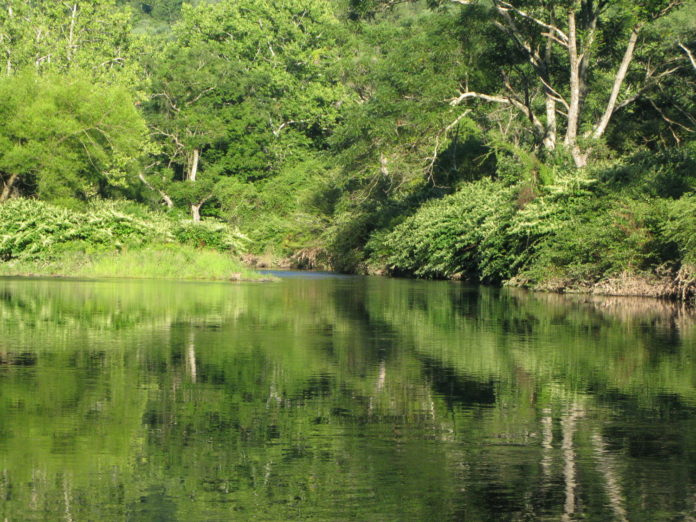By TONY BONAVIST
Logic might dictate that current weather conditions would be reason enough to forget fishing today. The local meteorologists report that this is one of the driest summers on record, with lawns, crops and trout streams suffering alike.
It is the last week in July; unbearably hot. The cornfields shimmer in the late afternoon sun and the rain does not come. There is no relief in sight, according to the weather guys. My thoughts wander as I drive along the river road, the setting sun in my eyes. This will be the first time this season that we will fish the upper river.
I meet two friends at the side road where we always park. They are anxious with anticipation and pummel me with questions about where to fish and what fly to use. When we arrive at the river, there’s a good hatch of Sulphur mayflies on the water and trout rising. I explain to my excited charges where to fish and give each of them a few flies before I head upriver. I cross at the tail out of a long flat pool—my destination—and continue on. The flow is quiet here and even my slow, careful steps send a series of ripples ahead, announcing my presence.
The sun is behind the mountain now and the surface takes on the color of black oil as I wade along. Sulphurs are hatching in earnest and birds are everywhere, snatching the hapless duns from the surface. As I continue on, recollections of other nights on similar flat pools along this river remind me, if I find rising fish, any that are coaxed to my fly will be earned.
As I move upstream, the pool widens and flattens a good hundred feet across. The flow is so quiet that the surface shows little movement, even though a considerable volume of water is pressing against my waders. It takes time to wade this type of water without scarring every fish in the pool, including those at a distance, so my progress is slow. Even so, upstream about 20 feet from the bank I see soft rings on the surface and watch with anticipation as each circle is erased by the flow.
These trout are a long way off, but from my position, it looks like a pod of six to eight fish feeding steadily. Experience tells me that if I do not spook these fish, it will be extremely difficult to place a fly over them. As I move closer, I see noses, dorsal fins and the tips of tails as the trout effectively vacuum the surface for the Sulphurs. I have seen this type of feeding before, and from the distance between the noses and tails, I’m looking at some 20-inch trout!
How to approach? I know that one careless step will put these fish down. A large willow leans over the water on my side, a mixed blessing. It will provide a foil to my silhouette but an obstacle to my back cast. I slowly wade toward it. When I reach the tree, the trout are about 60 feet away—too far for accurate casting. I need to be closer.
It’s 7:30; perhaps the oncoming twilight will work to my advantage? I’ve seen large fish lose caution and become greedy at dusk when there are a lot of flies on the water. But I know that I’m in for hundreds of casts with no mistakes. And I’ll feel immensely rewarded if I raise one fish under these circumstances.
The trout continue to feed and the drama builds. There are at least six large fish rising less than 50 feet away. I’m amazed at how little disturbance these trout make as they go about their work. Just a nose, a little noise, then a disappearing ring. I wade to about 40 feet and they stop. “You knew this would happen,” I say to myself. So, I know it will be a waiting game—if they come back at all.
In about 15 minutes, a trout rises against the far bank and rises again. Another fish rises, then another. The original pod is feeding again. I pick the closest fish: false cast, leader straightens, the fly settles, fly floats about a foot. Trout rises a foot to right. Everything is repeated: false cast, dry the fly, shoot toward the last rise, fish rises left, fish rises right, fish rises upstream, but not to my fly. It seems like I’ve been through this scenario thousands of times without raising a trout; it is haunting!
As the night closes and the bats begin to comb the surface, there is time to reflect on this very dry season, this river with its abundant flow of clear, cold water and what it has meant to me. Of all the people I shared its treasures with, some of them now departed. How beautiful and peaceful the river is and how lucky I am to be fishing at all when so many others have cased their rods. On this hot July night, I stood in 50-degree water, legs aching from the cold. Strands of green algae and beds of elodea wave with the current.
The trout continue to feed, but they seem unimportant now; I had my chances. In the fading light, I look up and down the river; there’s not another angler. So with the exception of the trout, bats and a few splashing mergansers, I’ve had the river to myself. Now, it’s time for the night to end and begin the long wade back, reminded of the experience I’ve had.
Credit: Source link































